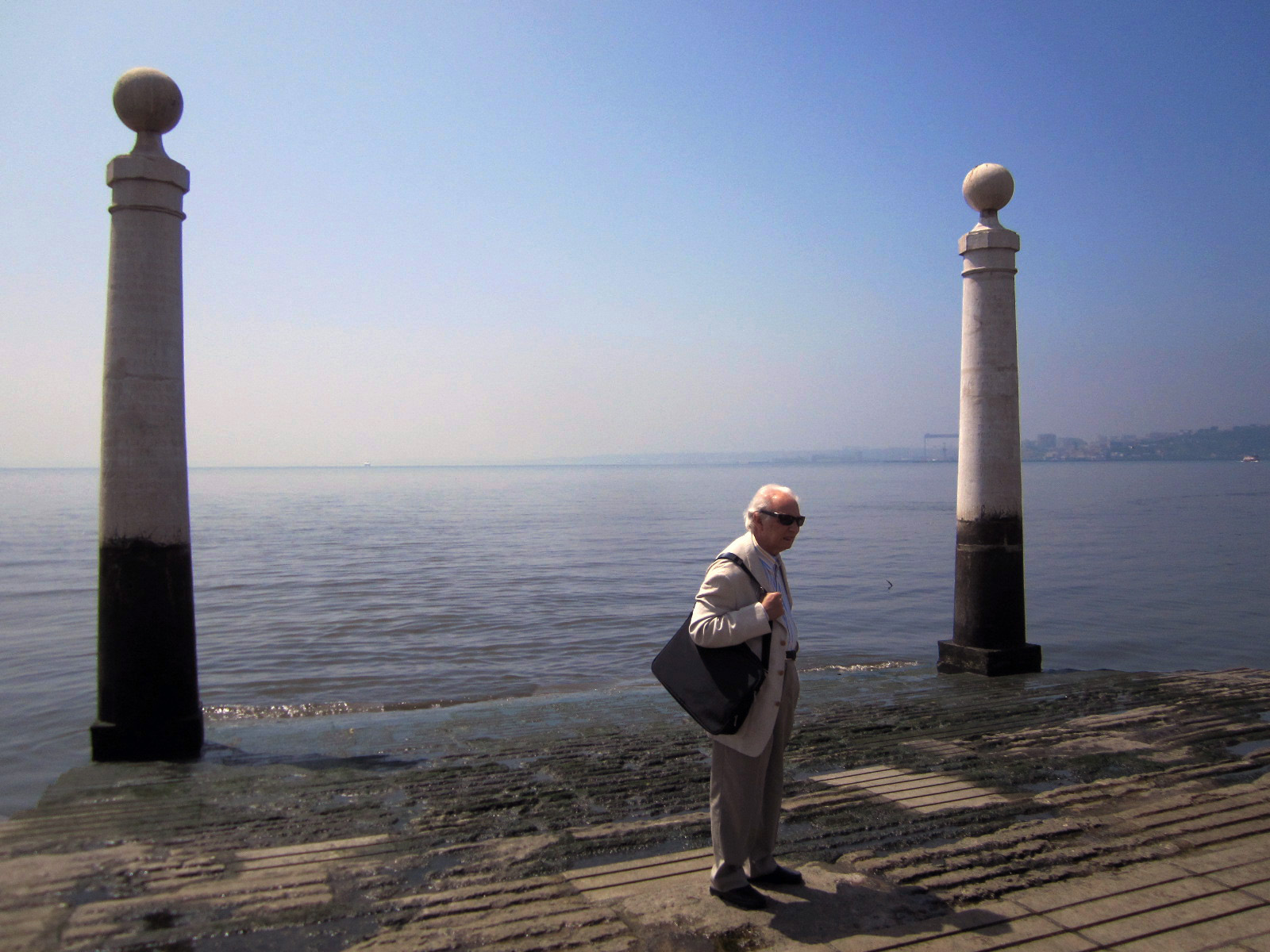 There are a lot of theories as to the origins of Lisbon. Ancient references hint that Ulysses discovered the location when he fled Troy. Cartographers of the 1st century mapped the settlement at the mouth of the Tagus River as “Ulyssipo”.
There are a lot of theories as to the origins of Lisbon. Ancient references hint that Ulysses discovered the location when he fled Troy. Cartographers of the 1st century mapped the settlement at the mouth of the Tagus River as “Ulyssipo”.
Some say the name came from the Phoenicians who called it “Allis Ubbo” (calm harbor) when they traded here between the 10th and 3rd centuries BC. The Romans called it “Olissipo”. The Visigoths called it “Ulishbona”. To the Moors it was “Al Isbunah”. Over the years it became Lisboa or Lisbon. The locals these days call it Lisa.
Lisbon is a big sprawling city of 3 million people. It has wide avenues and really bad traffic. Street signs are arbitrary, but the locals seem to know where they’re going, and so we just ask someone every time we get lost, which is about every three or four minutes.
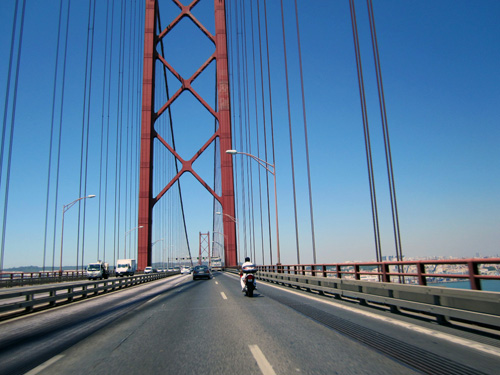 Lisbon’s 25th of April Bridge is the red bridge that’s often compared to San Francisco’s Golden Gate Bridge. It does have the color of the Golden Gate but actually, its a copy of the San Francisco-Oakland Bay Bridge, built by the same company (the American Bridge Company) in 1966.
Lisbon’s 25th of April Bridge is the red bridge that’s often compared to San Francisco’s Golden Gate Bridge. It does have the color of the Golden Gate but actually, its a copy of the San Francisco-Oakland Bay Bridge, built by the same company (the American Bridge Company) in 1966.
It used to be called the Salazar Bridge but was changed to the 25th of April after the revolution of 1974 finally overthrew the dictatorial government of Antonio de Oliveira Salazar who’s iron fist and goon squad known as the PIDE controlled the country from 1926 till 1974.
The traffic is usually bad on the 25th of April Bridge, but at 2pm we had no problems getting across. The problems didn’t start till the other when we ran into an accident that closed down the highway for around 45 minutes. It was one of those everybody get out of the car moments, get a change of clothes from the trunk, chat up the cars in the next lane, take a walk up ahead to see what’s happening. If it was a bit cooler we might have had some picnic blankets spread out on the highway. Finally, after the unfortunate cars were towed away, traffic began to move. Our reward was we were able to drive under the Lisbon aqueduct, a Roman style stone structure built in 1746. It’s 36 miles long with 109 arches. The 14 arches we went under were sensational. Amazingly enough, the aqueduct is one of the structures that didn’t fall over during the massive earthquake of 1755. So much of the life of this city surrounds the devastation of 1755.
 When we were here last in 1995, we noticed how much Lisbon is like San Francisco. They both have 7 hills and two main bridges. The cable cars of San Francisco and the electric trams of Lisbon look very much alike. Both cities were also destroyed by earthquakes. On April 18th at 5:12am, the 8.3 (estimate) 1906 San Francisco earthquake lasted about 60 seconds and was felt for 296 miles. . Over 800 people died in the quake and over 28,000 building were destroyed from the tremors and the subsequent fires.
When we were here last in 1995, we noticed how much Lisbon is like San Francisco. They both have 7 hills and two main bridges. The cable cars of San Francisco and the electric trams of Lisbon look very much alike. Both cities were also destroyed by earthquakes. On April 18th at 5:12am, the 8.3 (estimate) 1906 San Francisco earthquake lasted about 60 seconds and was felt for 296 miles. . Over 800 people died in the quake and over 28,000 building were destroyed from the tremors and the subsequent fires.
On November 1st, 1755 (All Saint’s Day) at 10:24am, while most of the Lisbon’s population was at church, the 8.8-9.0 lasted anywhere from 3 – 6 minutes. Since the Richter scale wasn’t invented till 1935, the magnitude of these quakes is just an estimate. Fissures 15’ wide opened up in the central city and people rushed to the water, trying to escape by boat, but when they got there, the water was gone. All they saw was sunken debris from ancient ships sunk in the harbor. They couldn’t figure out what happened the ocean, but they didn’t have to wait too long to find out. The tsunami wave that brought it all back smashed everything in its path. What wasn’t destroyed by tremors or water was hit by the subsequent fires. It took 5 days to put out the fires. Anywhere from 40,000 – 90,000 people were killed. Lisbon lost close to 1/3 its population.
Our apartment rental is just off the couture shopping of the Avenida da Liberdade, known as the 35th most expensive avenue in the world. Once you turn off the grand avenue, however, it’s a lot less fashionable and a lot more downscale. Our small cobblestoned street, Rua do Telhal, is two blocks away from the couture section. We have a tattoo parlor across the street, a few bars, a music store a S&M wig shop and buildings in a state of either demolition or renovation. We like it.
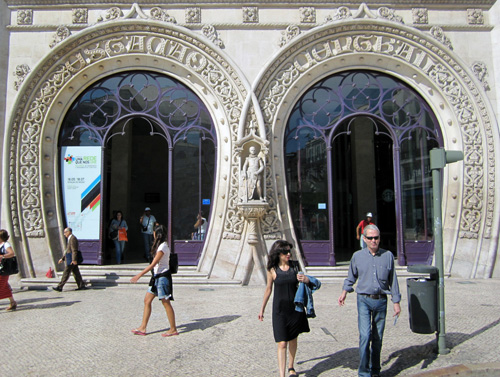 A left hand turn down the Avenida da Liberdade takes us through Rossio Square and towards the Tagus River. The City Squares run into each other as you get closer to the old town. The Plazas of Rossio, Sao Dominigo and Figueira all seem to blend together as they flow into the Baixa, the grid pattern created by the Marquis de Pombal’s redesign of the city after the 1755 quake. Rossio was built over an ancient Roman Hippodrome and you can still see the curve of the old track as it bends around the square in front of the 19th century Dona Maria II National Theatre.
A left hand turn down the Avenida da Liberdade takes us through Rossio Square and towards the Tagus River. The City Squares run into each other as you get closer to the old town. The Plazas of Rossio, Sao Dominigo and Figueira all seem to blend together as they flow into the Baixa, the grid pattern created by the Marquis de Pombal’s redesign of the city after the 1755 quake. Rossio was built over an ancient Roman Hippodrome and you can still see the curve of the old track as it bends around the square in front of the 19th century Dona Maria II National Theatre.
There is always movement in the square. The recently refurbished and restored 19th century Manueline style train station sucks people in and spills them out onto the Square throughout the day. Rossio is where a flower vendor gave a carnation to a soldier in 1974 and started the Revolution of Carnations that deposed the government of Salazar. It’s also where the Auto da Fe inquisisitions were held. 40,000 people were judged and over 1800 were burned alive in the center of the Square. These days it’s a great place to sit and watch the people of Lisbon.
At the center of Rossio the 89’ tall statue of Dom Pedro IV, maybe. As the story goes, it might just be a statue of the Emperor Maximillian of Mexico. In 1870 a ship with the statue was docked in Lisbon when Maximillian was assassinated by the forces of Benito Juarez in 1867. The Portuguese had also ordered the statue of Dom Pedro IV from the same French sculptor who made the likeness of Maximillian, and since there was already a perfectly good statue in the harbor why spend the extra money to complete another?
 The Baixa, the old merchants district wiped out by the tidal wave that came crashing onto the city after the 1755 quake, was rebuilt with much wider streets, really wide streets for the 18th century. Even the King questioned Pombal as to why they needed to be so wide. Pombal just replied, “Someday they’ll be too small.” He was right. By today’s standard they are pretty narrow.
The Baixa, the old merchants district wiped out by the tidal wave that came crashing onto the city after the 1755 quake, was rebuilt with much wider streets, really wide streets for the 18th century. Even the King questioned Pombal as to why they needed to be so wide. Pombal just replied, “Someday they’ll be too small.” He was right. By today’s standard they are pretty narrow.
The names of the streets still relate the old guild professions, Rua da Prata (Silversmiths’ Street), Rua dos Sapateiros (Shoemakers’ Street) and Rua do Ouro (Goldsmiths’ Street). You can still buy gold on the Goldmaker’s Street, or silver on the Silvermaker’s street. Of course you can by gold and silver of the street of the cod fishermen too. It is, after-all, one of the main shopping areas of the central city.
The buildings of the Baixa are first seismically designed buildings in the world. Pombal had troops of soldiers march on loose floorboards around the small wooden models of the building to check out the design. The models withstood a lot of vibration without tumbling over. Fortunately, the buildings that came from the models have never been tested by another earthquake. There hasn’t been another one since 1755.
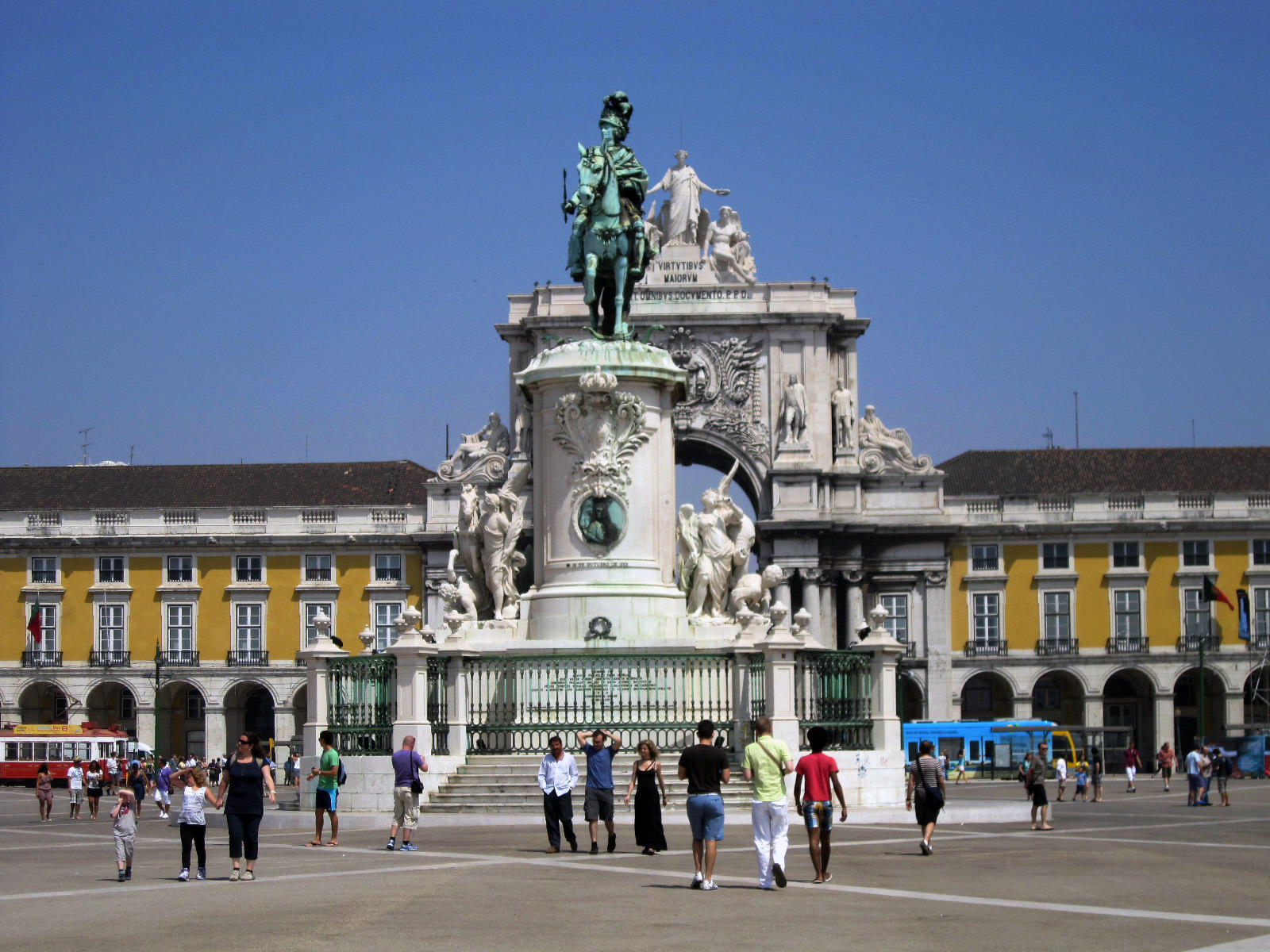 We walked down the cobblestoned, pedestrian only, Rua Augusta through the Victory Arch into the Comercio square, the prequake home of the Royal Palace. This stretch on Rua Augusts from Comercio Square up through the Rossio is the best place for people watching entertainment, day and night.
We walked down the cobblestoned, pedestrian only, Rua Augusta through the Victory Arch into the Comercio square, the prequake home of the Royal Palace. This stretch on Rua Augusts from Comercio Square up through the Rossio is the best place for people watching entertainment, day and night.
On our first night there, every few hundred feet we saw another street musician or band. The styles varried from Brazilian funk, to Fado, to a father and son accordion team, to the Peruvian pan pipe bands, to a Marvin Gaye impersonator to new age inverted steel drums, to folk singers and even a strange turbaned man who stands in wheelbarrow with a megaphone to his lips chanting out some strange Moorish incantations. Maybe we just got lucky because there was a big concert in Comercio Square kicking off Lisbon’s annual Ocean’s Festival.
The crowds are fascinating. There are the tourists, of course, from all over the world and the Lisboans, also from all over the world. When life got bad in the Portuguese colonies, the colonies immigrated to the motherland and these days the city is a melting pot of Brazilians, East Africans from Mozambique, West Africans from Cape Verde, Indians from Goa, Indonesians from East Timor and Chinese from Macao.
We caught the opening act of the concert, a band named Seda that played Portuguese hits from the 80’s but the crowds were too intense. We went back to the Rua Augusta which was just perfect for our tastes.
For years the crafts tables under the portico of the Victory Arch at the end of Rua Augusta have been known as the “Mercato dos Hippies”. It’s basically a small crafts market and everything is hand made. We were really excited to find some clay canarios, little birds that chirp like canaries when you fill them up with water. We look for these little birds wherever we travel and so far we’ve only found them in Zamora Spain, Aphrodisias Turkey and here in Lisbon. I can’t say we’re canario collectors but we have bought them wherever we find them.
 From the river we walked up towards the Castel Sao Jorge and stopped into the Sé (Grand Cathedral) to see the wedding inside. Hey, it’s always good luck to see a wedding.
From the river we walked up towards the Castel Sao Jorge and stopped into the Sé (Grand Cathedral) to see the wedding inside. Hey, it’s always good luck to see a wedding.
Lisbon’s Cathedral used to contain the relics of St Vincent but they mysteriously disappeared during the 1755 quake. However, the coffin the Saint is still somewhere inside and the pair of ravens kept within the cathedral grounds are supposed to be descended from the same birds which, according to the legend, miraculously guided the Saint’s boat to the city.
Allegedly, when Alfonso I, the first King of Portugal got word that Saint Vincent was buried in the Algarve, he sent an exploration to find it in 1173. The expedition was able to find the Saint by the ravens circling over the burial site. Ever since 1173, the seal of the city has been a boat with 2 ravens, commemorating the voyage.
Upward we climbed the hill to the Castello de Sao Jorge (Castle Saint George), dodging all the small electric Streetcars that are so emblematic to this city.
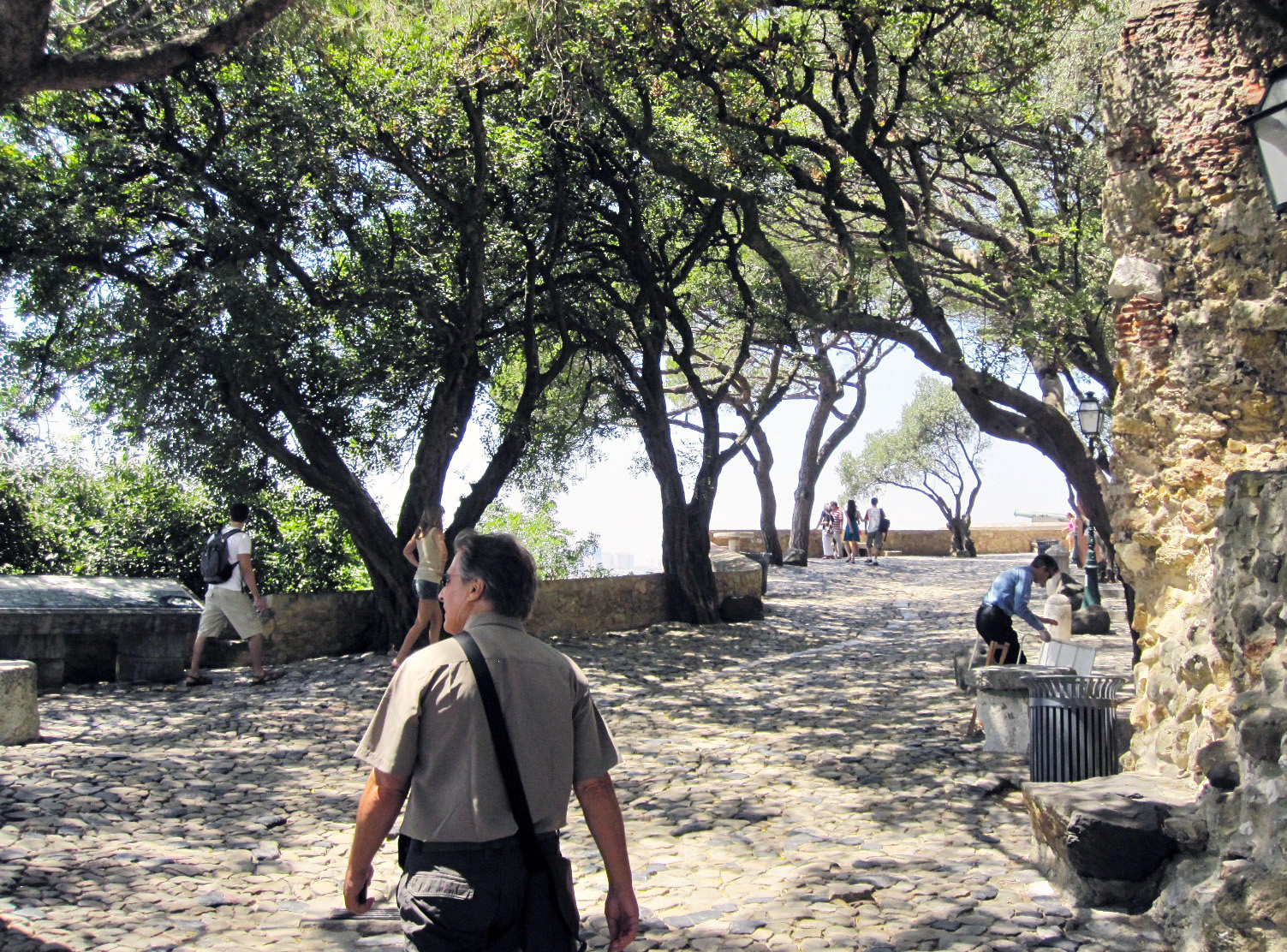 Sao Jorge was the original location of the city, used by Romans, Visigoths, Moors, and finally taken by the first Portuguese King Alfonso Henriques in 1147. We were here in 1995 and we remember the panoramic view of the city but we never remember going into the Castle. Maybe it wasn’t open for tourists back then. Maybe we were so blown away by the view we just never looked to our right to see the entrance. Anyway, we got it right this time.
Sao Jorge was the original location of the city, used by Romans, Visigoths, Moors, and finally taken by the first Portuguese King Alfonso Henriques in 1147. We were here in 1995 and we remember the panoramic view of the city but we never remember going into the Castle. Maybe it wasn’t open for tourists back then. Maybe we were so blown away by the view we just never looked to our right to see the entrance. Anyway, we got it right this time.
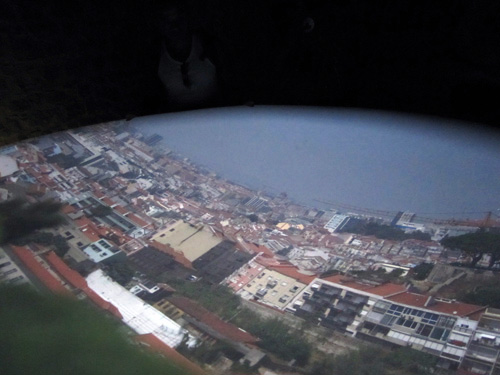 The walk is so peaceful and the towers and ramparts of the Castle are in really good shape. There are a few museum exhibits from the digs on the grounds going back to the 10th and 11th centuries, a few musicians and a camera obscura. This is the second one we’ve seen on this trip. Camera Obscuras are a unique way to see the city. Its a 360° view with a guide explaning what you’re looking at.
The walk is so peaceful and the towers and ramparts of the Castle are in really good shape. There are a few museum exhibits from the digs on the grounds going back to the 10th and 11th centuries, a few musicians and a camera obscura. This is the second one we’ve seen on this trip. Camera Obscuras are a unique way to see the city. Its a 360° view with a guide explaning what you’re looking at.
Belem
We started the day walking to the metro stop on Avenida but the gates were closed, but no big deal. We just walked up the Liberdade and caught the metro under the enormous statue of the Marquis de Pombal, standing next to a Lion and gazing toward his renovation of the Baixa.
The metro system here is new, it’s clean and it works great. Two stops later we were less than a five-minute walk from the Gulbenkian Museum.
Calouste Gulbenkian was a Turkish/Armenian oil tycoon and philanthropist who in his life assembled an amazing collection of over 6000 pieces. It’s one of the wealthiest private collections ever assembled and admission is free on Sundays. It’s a beautiful museum and every piece is exceptional. It really was a great museum and fabulous collection but I was too distracted. My thoughts were back in the 16th century Lisbon and I was eager to get over to the Belem area.
After a quick ride on the blue metro line and a quicker transfer to the green metro line, we exited at Cais do Sodré (train station, metro station and the seedy red light district) and hopped on the number 15 streetcar towards Belem. The one-day metro ticket (€4.50 euros) is good for any of the municipal transportation including metro trains, buses, streetcars, funiculars and the elevators up to the Barrio Alto. It’s a great system.
 Belem is the Portuguese word for Bethlehem and the area is formally known as the Santa Maria de Belem. It’s about 8km from the center of the Baixa along the mouth of the river. Although there is a flea market there on Sundays, but the main reason we came here was to see the Fortress Tower of Belem at the mouth of the River, the Manueline style Jeronimos Monastery and the 170’ tall Monument to the Discoveries. Its the photo at the top of the page.
Belem is the Portuguese word for Bethlehem and the area is formally known as the Santa Maria de Belem. It’s about 8km from the center of the Baixa along the mouth of the river. Although there is a flea market there on Sundays, but the main reason we came here was to see the Fortress Tower of Belem at the mouth of the River, the Manueline style Jeronimos Monastery and the 170’ tall Monument to the Discoveries. Its the photo at the top of the page.
The white limestone Belem Tower was finished under the reign of King Manuel I (the fortunate) between 1514 and 1520 as a reinforcement protection to the mouth of the Tagus River and to protect the Jeronimos Monastery close by.
Vasco de Gama set sail from here in 1497 to discover the sea route to India. In fact, the Tower and the Monastery were built from the money Manuel got from the spice trade from India. It was a fortunate spot for the Portuguese.
This was also where, in 1588, when Portugal was under Spanish rule, King Philip I of Spain sent 130 ships with 27,000 troops against Queen Elizabeth I of England. The position wasn’t so fortunate for him. The English won the war.
The Tower has been a fortress, a prison and a customs house. These days it’s one of the symbols of the city, often used in publicity shots from the chamber of tourism.
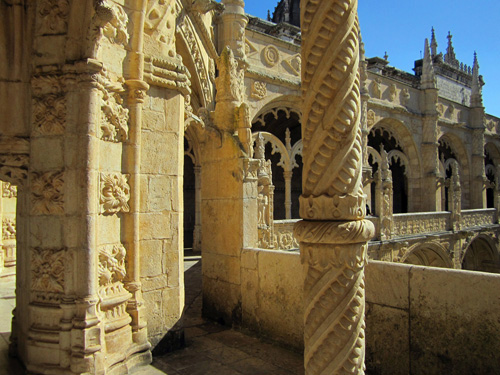 The Jeronimos Monastery is 10-15 minute walk from the Tower. If you are planning to see them both (and you should), buy the combined ticket.
The Jeronimos Monastery is 10-15 minute walk from the Tower. If you are planning to see them both (and you should), buy the combined ticket.
The exterior of the gold limestone Monastery is enormous but access to the public is limited to the grand vaulted arcades of the cloistered courtyard and a view of the massive cathedral.
It was built with the money from the spice trade from India in honor of Vasco da Gama, whose crew prayed in the original monastery before their voyage to India. The riches they brought back and the tax on the spices from India paid for the new Monastery. It survived the 1755 quake but in 1833 the King banned religious orders and the massive monastery was deserted. It became pretty run down but restorations over the years have brought much of it back to life. The National Archeological Museum and the Maritime Museum are located in the wings of the Monastery.
Both the Belem tower and the Monastery of Jeronimos are designed in what is now known as Manueline architecture, a mixture of Moorish and gothic with nautical themes, ropes, chains, shells, birds and armillary (astrolabe) globes. Its kind of rococo gothic. Manuel I was referred to as Manuel the Fortunate, and why not? He happened to be on the throne during the start of the greatest power surge Portugal ever had. During his reign Vasco da Gama discovered the sea route to India and Pedro Alvares Cabral discovered Brazil. The money came rolling in.
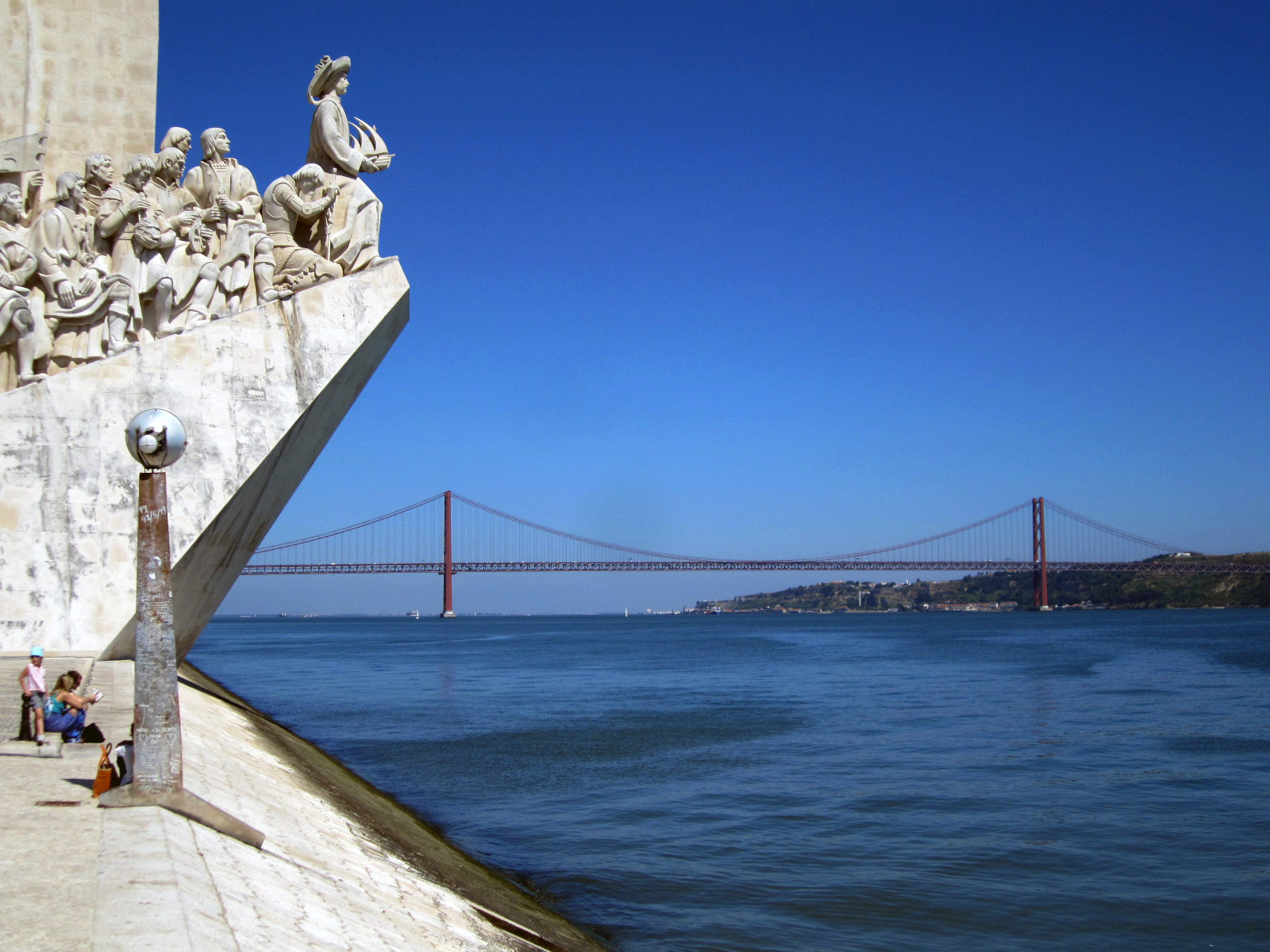 The other great attraction in the Belem is the Monument of Discoveries, a 170’tall ship prow cantilevered over the Tagus River. It’s a commemoration to the 15th and 16th century’s explorers who literally put Portugal on the map, actually all over the map. It was originally built of wood for the 1940’s world fair in Lisbon, but it became so popular that it was recreated into this massive Soviet Realist style concrete block in 1960. You can climb up inside the monument and get some impressive views of the city and the river but we were content to just look at it from the ground.
The other great attraction in the Belem is the Monument of Discoveries, a 170’tall ship prow cantilevered over the Tagus River. It’s a commemoration to the 15th and 16th century’s explorers who literally put Portugal on the map, actually all over the map. It was originally built of wood for the 1940’s world fair in Lisbon, but it became so popular that it was recreated into this massive Soviet Realist style concrete block in 1960. You can climb up inside the monument and get some impressive views of the city and the river but we were content to just look at it from the ground.
We read that 20 large buildings of the Chiado were destroyed by a fire in 1988 and the entire area was rebuilt. This area that sits just above the Baixa is now the most affluent part of the old central city, filled with upscale shopping, chain stores and beautiful buildings designed by Portugal’s premiere architect Àlvaro Siza Vieira.
We stopped for a beer at the “A Brasileira” (Brazilian woman). This famous café has been around since 1905. It was the first café in Lisbon to sell a small shot of coffee (similar to an espresso) called a “bica”.
 In the 20’s and 30’s this was one of the favorite hangs of Lisbon’s intellectuals and writers, especially the poet, editor and erstwhile occultist, Fernando Pessao, who drank here as often as possible until he died from cirrhosis at age 47. These days his bronze replica sits at a table with an empty chair inviting anyone to come and have a chat or a drink, or in most cases, a photo.
In the 20’s and 30’s this was one of the favorite hangs of Lisbon’s intellectuals and writers, especially the poet, editor and erstwhile occultist, Fernando Pessao, who drank here as often as possible until he died from cirrhosis at age 47. These days his bronze replica sits at a table with an empty chair inviting anyone to come and have a chat or a drink, or in most cases, a photo.
 However the main hang for Pessao and his friends was at the Café Martinho Da Arcada, in the arcade of Comercio Square. It’s the oldest café in Lisbon, opened in 1782 and it’s still a great meal. We ate there for lunch one day and it was so delicious, we went back for dinner and sat at the table of Ruy de Carvalho, a famous Portuguese actor. Every table sits under a photo of the famous Portuguese artist/patron who sat there. The house specially “loma marthino”, (beef fillet in a coffee cream sauce). It’s unusual, tender and delicious alongside a glass of Touriga wine. The desert called “encharcada” an egg and almond custard was the perfect choice to complete the meal and to finish off the last of the good red wine.
However the main hang for Pessao and his friends was at the Café Martinho Da Arcada, in the arcade of Comercio Square. It’s the oldest café in Lisbon, opened in 1782 and it’s still a great meal. We ate there for lunch one day and it was so delicious, we went back for dinner and sat at the table of Ruy de Carvalho, a famous Portuguese actor. Every table sits under a photo of the famous Portuguese artist/patron who sat there. The house specially “loma marthino”, (beef fillet in a coffee cream sauce). It’s unusual, tender and delicious alongside a glass of Touriga wine. The desert called “encharcada” an egg and almond custard was the perfect choice to complete the meal and to finish off the last of the good red wine.
 It’s Tuesday which means it’s “Feira da Ladra” day (the thieves market) at Campo de Santa Clara in the old Alfama. We couldn’t tell if the name was from the thieves who would go their to pickpocket the tourists or that the thieves were selling things they stole from other people’s houses. At any rate it’s a bizarre scene. Blankets filled with old junk sprawled across the square like items thrown out of a burning house. If you’re looking to improve your 8-track collection, this is the place to come.
It’s Tuesday which means it’s “Feira da Ladra” day (the thieves market) at Campo de Santa Clara in the old Alfama. We couldn’t tell if the name was from the thieves who would go their to pickpocket the tourists or that the thieves were selling things they stole from other people’s houses. At any rate it’s a bizarre scene. Blankets filled with old junk sprawled across the square like items thrown out of a burning house. If you’re looking to improve your 8-track collection, this is the place to come.
Campo Santa Clara is in the Alfama quarter, the oldest part of the city with small winding cobblestone streets and old world charm in need of repair. The Alfama was the only area in the central city to withstand the 1755 quake but 250 years later it’s looks like it’s starting to fall. Still, it’s a fun walk up and down the hills and get lost through small markets and antique shops and roads so narrow you have to literally hug the walls of the buildings to avoid the street cars as they pass.
 We hopped on the famous bus number 28 streetcar for a tour of the city and spent the next couple of hours hopping on a off various 28 cars. We’d take one to the end of the line and then hop on another. We eventually ended up getting back on the car we started the tour on. The driver laughed when he saw us again and waved a fond goodby as we got off directly in front of “A Brasiliera”.
We hopped on the famous bus number 28 streetcar for a tour of the city and spent the next couple of hours hopping on a off various 28 cars. We’d take one to the end of the line and then hop on another. We eventually ended up getting back on the car we started the tour on. The driver laughed when he saw us again and waved a fond goodby as we got off directly in front of “A Brasiliera”.
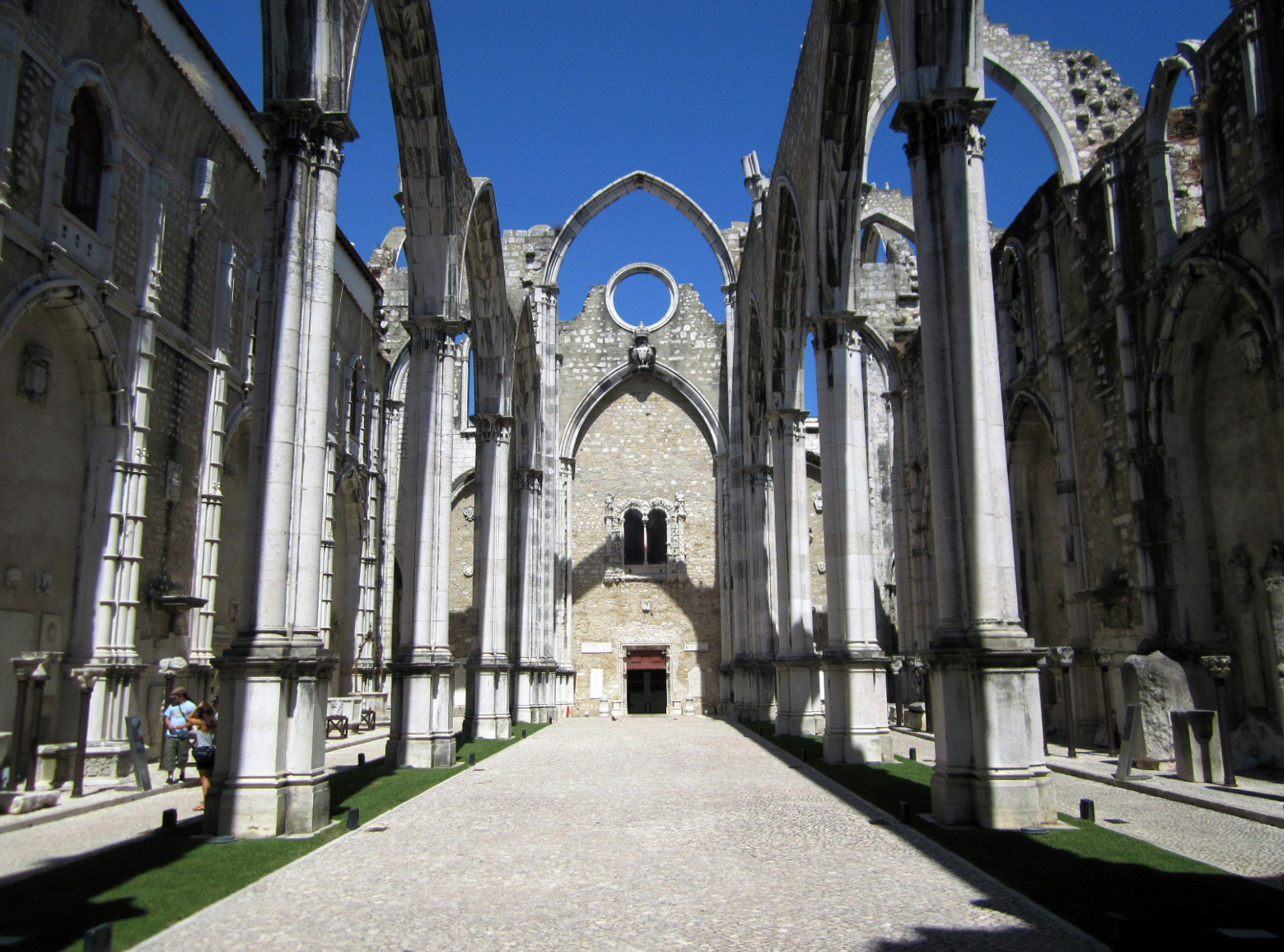 Nearby the Chaido is the ruined Gothic remains of the Convento do Carmo. This was once the largest church in the city, but after the 1755 earthquake and subsequent fire it was never rebuilt. It now stands as a reminder of the devastation. It’s also a pretty good archeology museum with elements going back to the Roman times. There are also 2 very strange Peruvian mummies in glass cases on display but we can’t figure our what they’re doing there. Shock appeal I guess.
Nearby the Chaido is the ruined Gothic remains of the Convento do Carmo. This was once the largest church in the city, but after the 1755 earthquake and subsequent fire it was never rebuilt. It now stands as a reminder of the devastation. It’s also a pretty good archeology museum with elements going back to the Roman times. There are also 2 very strange Peruvian mummies in glass cases on display but we can’t figure our what they’re doing there. Shock appeal I guess.
 We love walking through the Largo de Sao Domingos just to see how many people are hanging out at “A Ginjinha”, the most famous Ginja bar in the city. Ginja, a liquor made from morello (sour) cherries and sugar with a hint of cinnamon and fermented in brandy for 8 months. Served cold morning noon and night, its one of the passions of the Lisboans. People are always pounding shots of ginja at this bar. We had a few different versions at various locales and they were all really great. It smells sweet and alcoholic but it’s as smooth as cherry juice. The brand served at the Sao Domingos Ginja bar is exported to the US. The brand is Espinheira and sells for about $12 a bottle.
We love walking through the Largo de Sao Domingos just to see how many people are hanging out at “A Ginjinha”, the most famous Ginja bar in the city. Ginja, a liquor made from morello (sour) cherries and sugar with a hint of cinnamon and fermented in brandy for 8 months. Served cold morning noon and night, its one of the passions of the Lisboans. People are always pounding shots of ginja at this bar. We had a few different versions at various locales and they were all really great. It smells sweet and alcoholic but it’s as smooth as cherry juice. The brand served at the Sao Domingos Ginja bar is exported to the US. The brand is Espinheira and sells for about $12 a bottle.
Although these days, Largo Sao Domingos is the place of happy ginja drinkers, this was once the location of the most horrible religious provoked attacks of Portuguese history. On Easter Sunday in 1506, a mob lashed out at the newly converted Christians, Jews who were forced to convert during the inquisitions of 1496. When the “new” Christians insisted the sunlight shining through the rose window of the church onto the altar cross was a natural occurrence and not a divine miracle, the insult turned into a bloodbath. Within three days, close to 4,000 “new Christians” were slaughtered. Everyone suspected of being a Jew was killed. They were blamed for the plagues, the draught, and the shortage of food. Anything and everything bad was blamed on the Jews. The mob was incited by Dominican Friars, spreading the rumor that killing a Jew would bring them 100 days of absolution. Pregnant women thrown onto stakes, babies dismembered, innocents burned alive.
After it was all over, the leaders and instigators of the riots were executed by King Manuel I. The Dominican friars who urged the riots were executed. Locals convicted of murder or stealing from the victims were executed and the Jews who remained were offered new religious freedoms. However, most of the remaining “new Christians” fled for their lives.
In 2006, a monument was placed in the center of the square in the shape of the Jewish Star of David commemorating those who lost their lives in such a stupid tragedy.
One more thing to say about Portugal is the food and wines are delicious. We filled ourselves with franga piri piri (spiced chicken), grilled Orata (Dorado) called gold fish, local salmon and bacalhau com nata, codfish with cream, flour, onions, garlic and potatoes, baked in the oven till the top is brown and crispy. Codfish is the national dish. The Portugese eat so much of it they have depleted the local catch and now import most of the cod. The pastries of Lisbon should not be missed. Get yourselves a good helping of pastel com nata and trasseiro.
Sintra
The Rossio Train station, a beautiful exterior but very small train station is a short walk from our apartment. The trains to Sintra depart every 15 minutes. Why so many trains you ask? We think it’s because it takes at least 20 minutes to buy your tickets. There is a ticket window manned with one person who was serving a line that stretched a good 100 feet long. There were also six or so self serve ticket machines with instructions in Portuguese only. We opted for the ticket machines thinking they couldn’t be much different than the ticket machines we used in Rome, Venice, Milan or Berlin. Wrong again. We were able to figure out how to choose Rossio as the departure point and how to select Sintra as the destination and then added what we thought were 2 tickets. When the machine wouldn’t take the euro bills, we figured it would only accept coins because it had no change. We’d run into this problem before as well. We bought the 2 tickets but only one ticket was printed. We figured it was just a different system until we got busted at the turnstile by a security cop who explained to us we only had one ticket and needed to buy another. As it turned out we bought two trips, not two tickets. This would have been OK if we had more coins in our pockets. But change was scarce. No one had exact change. It was kind of funny watching people turning their pockets inside out looking for coins. Even the Starbucks in the lower level of the station wouldn’t give us change until we bought a .60-cent commemorative Starbuck’s chocolate coin (terrible by the way). But as I said, the train to Sintra runs every 15 minutes. Not that big a deal.
It is a 40 minute ride (with 12 stops along the way) to Sintra. The journey is filled with rundown apartment complexes that scar the countryside but the payoff is Sintra, the summer residence of the Portuguese Kings. Its a totally different country. We’re up in the mountains and it’s 25° cooler.
We came to visit the Castle of the Moors , the 19th century royal summer Palace and the old Sintra town, but we had no idea where we were going. There were no map and so when we saw a group of people walk across the street and up the hill we decided to follow them. We figured we’d end up somewhere. Way up on the top of the hill we could see the Castle of the Moors riding the crest of the hill like a dragon. At this point in the day, we never thought we’d be walking up there. But, we did.
The walk to the old town was a pleasant 20 minutes through a modern art exposition and an old Moorish water well where locals fill up with mountain spring water.
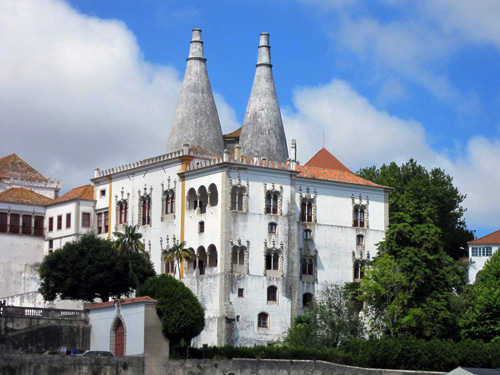
The town is a quaint village built up and around small winding streets around the old Royal castle with 2 tall chimneys that look like inverted megaphones. After a couple of coffees, a pastel da nata (custard tart) and an oblong almond filled pastry called “Travesseiro”, we set out to find the Castle.
 A local shopkeeper gave us the short cut route which would take about 30 minutes, and so up the stairs, around the old house where Hans Christian Andersen once lived, through the revolving door into the old forest, up the ancient stone steps and up and up and up until about an hour later, we finally made it to the 9th century ancient stone Castle of the Moors. The way it climbs over the crest of the hills, it looks like a mini Great Wall of China. The winds are so strong up here you really have to watch your footing on the old stone steps. We just kept on asking ourselves, “how did they do it?” It’s amazing, the views, the towers, the crenellated walls. It’s one of the most fun times we’ve ever had in an old Moorish castle.
A local shopkeeper gave us the short cut route which would take about 30 minutes, and so up the stairs, around the old house where Hans Christian Andersen once lived, through the revolving door into the old forest, up the ancient stone steps and up and up and up until about an hour later, we finally made it to the 9th century ancient stone Castle of the Moors. The way it climbs over the crest of the hills, it looks like a mini Great Wall of China. The winds are so strong up here you really have to watch your footing on the old stone steps. We just kept on asking ourselves, “how did they do it?” It’s amazing, the views, the towers, the crenellated walls. It’s one of the most fun times we’ve ever had in an old Moorish castle.
Even though it looks impenetrable, it wasn’t. It was attacked and defeated by the Norwegian Crusade of Sigurd I in 1109. The Moors came back again, but in 1147, they were overtaken by King Alfonso Henriques (the first King of Portugal). The Castle was inhabited till the 15th century. Now it’s part of the Sintra National Park.
From the Castle Fortress, we walked back down the hiking paths and over to the next hill. 30 minutes later, as we arrived to the road leading up to the Pena Palace, a large public bus passed us. We looked at each other and said, “and that’s how we’re getting back down to the town”
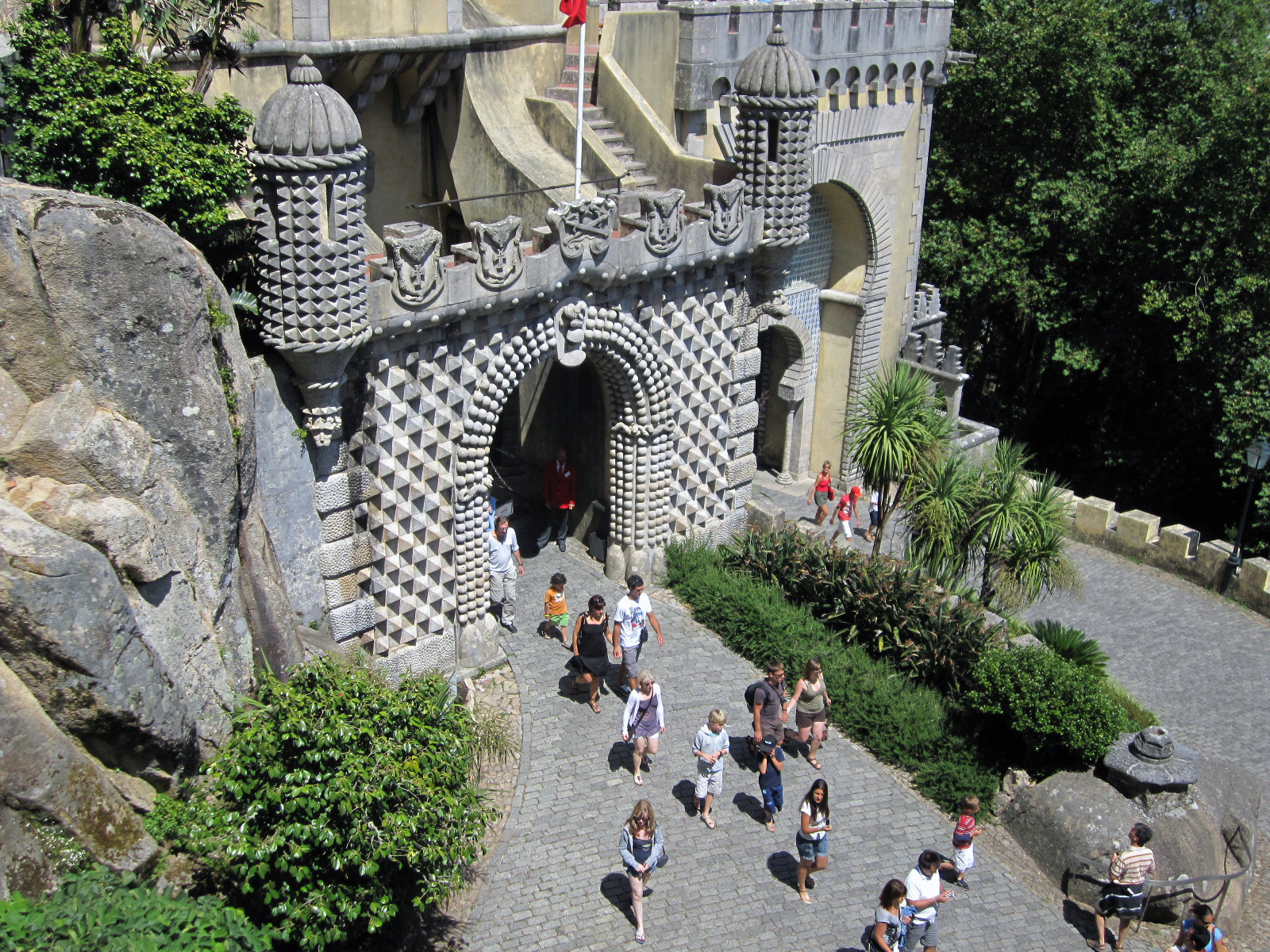 The Pena Palace was the summer house of King Ferdinand II and Queen Maria II built on the peak of the hill above an old Monastery where an apparition of the Virgin Mary occurred in 1493. Portugal has had a few visitations by the Virgin Mary, the most famous happened in Fatima in 1917.
The Pena Palace was the summer house of King Ferdinand II and Queen Maria II built on the peak of the hill above an old Monastery where an apparition of the Virgin Mary occurred in 1493. Portugal has had a few visitations by the Virgin Mary, the most famous happened in Fatima in 1917.
This is a bizarre fantastical Palace. It’s a nod to classical romanticism, Moorish, Manueline, and just plain kitsch. It’s just the kind of thing Walt Disney would have loved.
King Ferdinand II gave the job to an amateur German architect named Baron Wilhelm Ludwig von Eschwege, a military officer and mining engineer who’s only knowledge of Palaces was from his visits to the German castles along the Rhine. To his credit though, he got the Castle into move in condition in just 7 years (1840-1847). The next seven years Ferdinand II and Mary II made “alterations” to fit their tastes. It’s hard to tell whose taste was stranger, the German engineer or the Royals.
We crowded into the 434 bus at the Palace and took the stomach heaving ride down to the old town where we got off and walked the final 20 minutes to the train station and back to Rossio square. It’s one of the best Day Trips we’ve ever taken.
You must be logged in to post a comment.